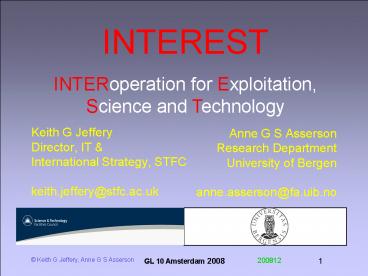Keith G Jeffery - PowerPoint PPT Presentation
1 / 25
Title:
Keith G Jeffery
Description:
Title: Relating Intellectual Property Products to the Corporate Context Created Date: 10/24/2004 10:27:58 AM Document presentation format: On-screen Show – PowerPoint PPT presentation
Number of Views:70
Avg rating:3.0/5.0
Title: Keith G Jeffery
1
INTEREST INTERoperation for Exploitation, Science
and Technology
- Keith G Jeffery
- Director, IT
- International Strategy, STFC
- keith.jeffery_at_stfc.ac.uk
- Anne G S Asserson
- Research Department
- University of Bergen
- anne.asserson_at_fa.uib.no
2
Authors
Keith G Jeffery STFC-RAL
Anne Asserson UiB
3
Structure
- Background
- The Hypothesis
- Conclusion
- Remote Wrapper
- Local Wrapper
- Catalog
- Catalog Plus Pull (ERGO2)
- Full CERIF
- Harvesting
4
Background GL
- Grey literature is important but is only a small
component of the total research information
environment and must be seen in context of the
overall research process - Grey literature is a product
- To understand the product need to have
information on the sources and the process i.e.
the research context - ? Do not try to obtain information through a
fog backwards from GL metadata - ? Get it moving forwards through the research
process then much GL metadata derived directly
and consistently
5
Background Access
- Interoperation homogeneous access to distributed
heterogeneous information - Query against schema (of user)
- Translation to other schemas (of sources)
- Answer reconciled to original schema (of user)
- If common interoperation format n interfaces
- If not n(n-1) interfaces
- Utilise one common interoperation format
- Character set, language, syntax, semantics
- The alternative is google-like where the
end-user has to do the translations and
reconciliations - This does not scale
6
Background Metadata
- Grey literature repositories can be interoperated
without CERIF-CRIS using OAI-PMH and DC (OAISTER) - Grey Literature Repositories provide better
recall and relevance when interlinked via
CERIF-CRIS research context - formal syntax, declared semantics
- Metadata
- Schema, Navigational, Associative descriptive,
restrictive, supportive - The key to everything is quality metadata
- input validation, query/retrieval, relationship
linking, INTEROPERATION
7
Background
Funding Programme
Classification
CERIF EU Recommendation to Member States
8
Result PublicationInstance Diagram
OrgUnit M
Part of
member
Person A
OrgUnit O
employee
member
OrgUnit N
Part of
Project leader
Project P
author
owns IPR
Metadata in CERIF-CRIS much richer than usual
repository
Publication X
9
CERIF- CRIS Repositories at 1 institution
10
.and multiple institutions
11
Hypothesis
- Comparison of possible architectures for
interoperation of grey repositories - (of publications or data and software)
- Leads inexorably to ?
- CERIF should be used either
- as the native storage format,
- as the storage format of a derived data warehouse
(transformed copy of the CRIS) - as the export format converted from the CRIS
native format using a wrapper.
12
Remote Wrapper
Query convertor
13
Remote Wrapper
- the user needs only web browser and simple query
form - the host has to write query converter
- the host has to write answer (XML?) converter (to
a specific XML DTD?) - the query expressivity is very limited
- the user client has to write an integrator for
the answers
14
Local Wrapper
15
Local Wrapper
- each host has only to supply and update its
schema to the client (all clients if there is not
a central query server) - each host has no software to provide except
receiver and dispatcher - the client (if it is a central service) has a
very large workload - if there is no central service then each client
has to have all schemas supplied and updated - the client software has to include a complex
query refiner - the client software has to include multiple
complex query converters - the client software has to include a complex
answer integrator - the client software has to include a presentation
converter (complexity depends on specification of
presentation required and complexity of the
answer structure)
16
Catalog
17
Catalog
- simple query on union catalog (which may be
centralised or replicated) - possibly not all required entities and attributes
in catalog - effort to populate catalog requires converter at
each host to supply CERIF metadata
18
Catalog Plus Pull (ERGO2)
User phase1
User phase2
Query form
Presentation form
LAN
Query
Hit list processing
CERIF Metadata Catalog
dispatcher
receiver
addresses
network
receiver
dispatcher
receiver
dispatcher
addresses
addresses
Unique id query
Unique id query
ltltlt non-CERIF CRISs gtgtgtgtgt
19
Catalog Plus Pull (ERGO2)
- advantage of simplicity as for catalog-only
architecture - advantage of additional information provision
- disadvantage that additional information is
heterogeneous (unless converted to CERIF export
data model) - disadvantage of hosts having to maintain entries
representing their database content in the CERIF
metadata catalog
20
Full CERIF
user
Query form
Presentation form
LAN
dispatcher
receiver
addresses
network
receiver
dispatcher
receiver
dispatcher
addresses
addresses
Query
Query
ltltltltlt CERIF CRISs gtgtgtgtgt
21
Full CERIF
- very simple and easy to use for the end-user
- each host has to either run a full CERIF model
database or provide a full CERIF model version of
the host database
22
Harvesting (construction phase)
23
Harvesting (search phase)
24
Harvesting
- The host has to provide a copy of the database as
webpages to be available to the search robot and
subsequent accesses based on clicks from URL of
metadata. - The query is based on existence of term(s)
constraining by entity or attribute is not
possible (without sophisticated xml form
processing). - The results are unstructured and one page at a
time (click on URL in metadata catalog to see
page) this inhibits statistical processing or
report generation. - It is easy to implement and maintain (although
the database may be 2 weeks out of date) and has
a familiar interface for many WWW users.
25
Conclusion
- To interoperate grey repositories link to a CRIS
- Best Full CERIF architecture
- Else wrap CRIS to interoperate using CERIF































